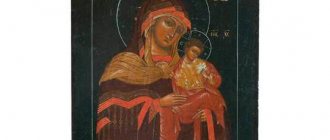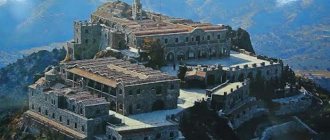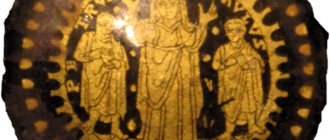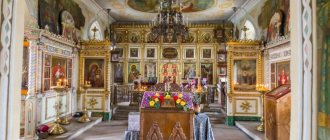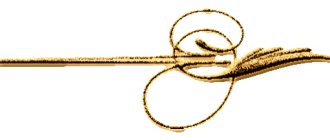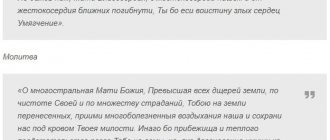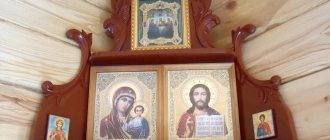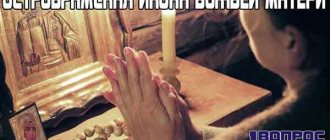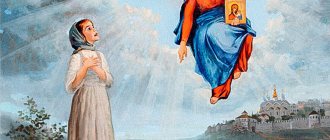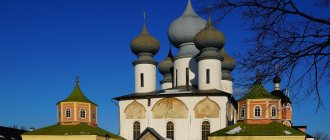The Orthodox Church and believers mourn for all the dead and dead. The death of an unborn baby is always a tragedy, but what if it is an actual murder committed by its mother? And then how can this woman live in the world, how can she then atone for her sin before the Lord?
The icon mourning the babies in the wombs of the murdered makes us realize anew the tragedy of the fact that the soul placed by God in every human being, already living or still in the womb of the mother, was not allowed to be born, and thereby not allowed to fulfill the will of God.
History and time of painting of the icon of the Mother of God “Sorrowful of the Infants”
The icon of the Mother of God “Grieving for Babies” was painted in the 21st century. The idea for her iconography came to the Ukrainian artist Tatyana Korsenko in the summer of 2010, when she was recovering from an illness in the village of Cheberyaki, Sumy region.
Tatyana likes to look for subjects for sketches in the intricacy of spots and lines on ordinary stones and transfer them to paper. This happened this time too:
“Out of habit, I picked it up and began to examine a lonely pebble lying near an old rural hut. And suddenly the clear image of the icon began to appear more and more clearly. It was like a flash, like an insight. The plot, outlined by living natural lines, resembled the images of the Virgin Mary, Christ and the child held by an Angel. The tiny image had to be quickly captured in pencil over the lines on the stone so that they would not get lost. She left the yard behind the house, where it was lighter. She sat down in the grass on the hill and began tracing silhouettes.”
Tatyana Korsenko, artist
Having secured the drawing on the stone in this way, Tatyana took her precious find to Kyiv. There she turned to her friend, artist and icon painter Yuri Sorokoletov. Together they carefully worked out the sketch and showed it to the rector of the Kyiv St. Macarius Church - Father Vladislav Sofiychuk.
- Before Father Vladislav, Father George Edlinsky was the rector of the Church of the Hieromartyr Macarius. Thanks to him, the Makarievsky parish has long accepted the rite of repentance “Wives who destroyed babies in their wombs.” There is an anti-abortion movement here now.
The idea for the icon came at just the right time. Father Vladislav sent the sketch to the Kiev Pechersk Lavra for approval. Metropolitan of Kiev and All Ukraine Vladimir (Sabodan) immediately approved it without any comments and blessed the creation of the image.
“No one expected such a gift for our church, although the church had been praying for the appearance of such an icon for 40 years.”
Father Vladislav Sofiychuk, rector of St. Macarius Church
Prayer text
Before the icon of the Mother of God awaiting the birth of the Child, the following prayer is read:
“O Most Holy Lady Lady Theotokos, who never leaves us in earthly life! To whom will I offer prayers, to whom will I bring tears and sighs, if not to You, Comfort to all the faithful! With fear, faith, love, Mother of the Belly, I pray: May the Lord enlighten Orthodox people to salvation, may He allow us to give birth to children for You and Your Son to please You, may He keep us in the purity of humility, in the hope of salvation in Christ, and grant us all, in the veils of Thy grace, earthly consolation. Keep us under the canopy of Thy mercy, Most Pure One, help those who pray for childbirth, turn away the slander of evil freedom, grave troubles, misfortunes and deaths. Grant us grace-filled insight, a spirit of contrition for sins, grant us to see all the height and purity of Christ’s teaching given to us; protect us from disastrous alienation. May we all, who gratefully praise Thy greatness, be worthy of Heavenly tranquility and there with Thy beloved, with all the saints, let us glorify the One God in the Trinity: the Father and the Son and the Holy Spirit, now and ever, and unto the ages of ages. Amen".
Iconography and meaning of the icon of the Mother of God “Grieving for Infants”
In terms of iconography, “Mourning for the Innocents” does not belong to any of the existing types of images of the Virgin Mary. The plot of the icon is unique, and it is not difficult to recognize it:
- a half-length image of the Mother of God supporting the Infant with her right hand;
- The head of the Mother of God is tilted to the right, her cheek touches the head of Christ;
- The Divine Infant stands on the Mother’s knee, his legs are covered with the folds of her omophorion;
- the left hand of the Mother of God repeats the gesture of Hodegetria, pointing to Christ, but at the same time holds an angel with a figurine of a swaddled baby in her arms;
- The Infant God stretches out both hands towards the angel, preparing to receive the murdered baby from him.
The Icon of the Mother of God “Grieving for Infants” makes a strong impression with its internal drama:
“There are no blessing gestures here, traditional for Russian icons. All the action takes place inside the composition, and the only thread that is extended to the viewer is the left hand of the Virgin Mary, which shows: pray to Christ for forgiveness! This is a purely repentant icon, it has no other meanings.”
Elena Belova, art critic
- The icon “Grieving for Babies” is made in gold and red tones. Red, in this case, is the color of martyrdom, emphasized by the stream of blood pouring from the swaddling clothes of the baby. Gold is a symbol of unquenchable divine radiance.
Speechwoman of the Arts
With the blessing of Archbishop Mark of Khabarovsk and Amur, the icon of the Mother of God “The Blessed Womb - Khabarovsk” was painted the 400th anniversary The icon with the name “Khabarovsk” has been known... since 1664. The Khabarovsk icon of the second half of the 17th century, kept in the Vladimir-Suzdal Museum-Reserve, served as the original for the modern icon painter from which the copy was made.
In 1664, the Ryazan icon painter Ivan Avksentiev painted an icon of the Mother of God of the Mammal, which he signed as “Khabarovsk”. On this icon, the Mother of God is depicted in a generational position, slightly turning to the right. Her head is inclined to the right towards the Baby, whom She is breastfeeding. With her left hand, the Mother of God supports the Baby, with her right hand she touches his legs. The Child Christ is depicted reclining on the Mother's lap. Mary's hair is not hidden by a cap (as is usually depicted on icons of the Mother of God), but flows down along her face and neck in dark brown strands. Clothes are rich pinks and greens with gold patterns in the form of stars and flowers. The borders and sleeves of the Mother of God's robe are decorated with gold inscriptions from the 44th Psalm, which prophesies the glory of the Mother of God. The personal is written on the greenish sankir with highlights that create volume.
This icon was a copy of the Barlovskaya icon of the Mother of God “Blessed Womb”, which was very revered in Rus'. Until 1924, it was located in the Annunciation Cathedral of the Moscow Kremlin; at present, its location is unknown. The Barlovskaya icon was revealed on December 26, 1392. The name of the icon “Blessed Womb” was the lines from the Gospel of Luke “Blessed is the womb that bore You, and the breasts that nourished You” (Luke 11:27). According to a handwritten collection of the 18th century, the image was brought to Moscow from the Italian city of Bari, where it was at the tomb of St. Nicholas, Archbishop of Myra, hence the second name of the icon - “Barlovskaya”. The special veneration of the Barlovsky image of the Mother of God is evidenced by the fact that in the Annunciation Cathedral it was placed opposite the royal seat, and in the second half of the 17th century the icon was renewed by the head of the icon painters of the Armory Chamber, Simon Ushakov. The Mother of God on the Moscow icon was depicted in generations, and the Infant Christ was depicted reclining and drinking milk from Her breast.
So, in the second half of the 17th century, from the ancient Barlovskaya icon of the 14th century, Ivan Avksentiev made a list, on the lower field of which he placed the inscription: “... in the year of January this image was copied from the miraculous image of the Greek letter, it is called Khabarovsk and stands opposite the royal place on the plaque of the Annunciation of the Blessed Virgin Mary the sovereign in the entryway, and the icon painter Ioan Avksentiev copied the Archbishop Hilarion of Ryazan.” This text is repeated in the carved inscription on a silver plate mounted on the back of the icon, and the year of writing of the icon, lost at the beginning of the inscription on the front side, was preserved on the back: “In 1664, in January, this image was copied from the miraculous image of the Greek letter called Khabarovsk and stands opposite the royal place on the naloya in the Church of the Annunciation of the Blessed Virgin Mary in the sovereign’s vestibule, the icon painter Ioan Avksentiev copied Archbishop Hilarion of Ryazan.” As art critic M.A. Bykova notes (Icons of Vladimir and Suzdal. M.: Northern Pilgrim, 2006. pp. 387–388), the ancient miraculous Barlovskaya icon of the 14th century has not survived and is known from several lists. The earliest of them - a 16th-century icon in a gold frame from the turn of the 14th-15th centuries from the Novodevichy Convent - is closest to the Suzdal icon.
Probably, Ivan Avksentiev received an order to complete the copy of the miraculous Barlovskaya icon from the Annunciation Cathedral of the Moscow Kremlin from Ryazan Archbishop Hilarion, who was consecrated Archbishop of Ryazan and Murom in 1657 and received the rank of Metropolitan in 1669. We do not know where the Khabarovsk Icon of 1664 was located after it was painted. It can be assumed that the icon was donated to the Spaso-Evfimiev Monastery by Metropolitan Hilarion himself or someone from the metropolitan’s entourage after his death in 1673.
The name of the icon “Khabarovskaya”, presumably, did not appear by chance: at that time the name of Erofey Khabarov was on everyone’s lips. And it is not surprising that the icon, which became a copy of the Barlovskaya icon, received the name Khabarovsk (the consonance “helped”). Thus, according to the Providence of God, the Khabarovsk Icon appeared two hundred years before the founding of Khabarovsk. After the sad events of the destruction of Russia and its culture began in the 20s of the twentieth century, the icon shared the fate of many masterpieces of Russian icon painting - it turned into a museum exhibit, since the Spaso-Evfimiev Monastery in Suzdal became part of the complex of the Vladimir-Suzdal Museum-Reserve. The monastery still belongs to the state, and the icon is kept there in the museum collections to this day.
In the year of the 400th anniversary of the birth of Erofei Pavlovich Khabarov, with the blessing of Archbishop Mark of Khabarovsk and Amur, it was decided to make a copy of the museum icon, a reproduction of which was placed in the catalog “Icons of Vladimir and Suzdal”, published by the Moscow publishing house “Northern Pilgrim” in 2006. The place where the new icon was created was the icon-painting workshop of the Khabarovsk Theological Seminary, and the famous Khabarovsk icon painter, nun Irina (Moroz), received the blessing to paint the icon. Archbishop Mark gave his blessing to fill the new icon with new content: to depict saints in the margins of the icon who, in one way or another, belong to our blessed Khabarovsk land. On the day of the first graduation from the seminary, June 24, 2010, the icon was solemnly brought into the Transfiguration Cathedral and consecrated by the archbishop and the council of clergy. The icon of the Mother of God became a gift to the Khabarovsk land from the seminary. The creation of the icon would have been impossible if not for the help of the parishioners of Khabarovsk churches, who happily responded to the seminary’s call to raise funds necessary to paint the icon. Thus, our land found a new shrine, and its creators were the ruling bishop, the clergy, the regional seminary, and parishioners - that is, the entire Khabarovsk diocese.
The Khabarovsk Icon of the Mother of God belongs to a relatively rare selection for Russian icon painting. Images of the Virgin Mary breastfeeding the Christ Child are already known in early Christian art. This subject was especially popular in post-Byzantine Italo-Greek painting. In Rus', such images have been distributed only since the 17th century. They are characterized by a generational cut of the figure of the Mother of God, her flowing hair under the maforium and the image of a reclining Child. All these features are preserved by the Khabarovsk icon, the middle of which is completely oriented towards the icon of the 17th century.
The icon is crowned with “The Savior Not Made by Hands” - an image that has always accompanied Russian people on campaigns. On the margins of the icon there are 12 stamps with images of saints. In the top row there are two apostles - St. Thomas the Apostle (according to legend, he preached in India and reached the borders of the countries of the Asia-Pacific region) and St. Mark the Apostle (the heavenly patron of the ruling bishop of the diocese, under whom the icon was created). Next to the apostles are the holy bishops - the holy martyr Erofey, Bishop of Athens (heavenly patron of Erofey Pavlovich Khabarov) and St. Nicholas, Archbishop of Myra (heavenly patron of Count Nikolai Nikolaevich Muravyov-Amursky, patron of travelers). Next are Saint Innocent of Irkutsk (missionary of Eastern Siberia) and Saint Innocent of Moscow (apostle of the Far East and North America). Below them are Hieromartyr Peter, Metropolitan of Krutitsky and Kolomna (during his tenure as Locum Tenens of the Patriarchal Throne, the Khabarovsk diocese was opened in 1925) and Hieromartyr Eugene, Metropolitan of Gorky (1913-1914 - vicar of the Irkutsk diocese, 1914-1923 - Bishop of the Amur and Annunciation).
In the bottom row is depicted the Holy Equal-to-the-Apostles Mary Magdalene, since the first church building on the site of present-day Khabarovsk was a chapel in her honor on the Amur cliff. Another woman is also depicted - the holy martyr Grand Duchess Elizabeth, in whose honor one of the Khabarovsk churches is consecrated in our time. In addition, in the bottom row are the faces of St. Nicholas of Japan and St. John of San Francisco and Shanghai, which are directly related to the Far East.
The iconographic features of some saints from the Khabarovsk icon are very interesting. Since ancient times, icons of saints have been known, where they are depicted holding in their hands a temple or monastery, the heavenly patron of which they are. This iconographic tradition was taken into account when depicting saints associated with Khabarovsk. Thus, Saint Innocent of Irkutsk on our icon holds in his hand the Holy Innocent Church - the first stone church in Khabarovsk, Saint Innocent of Moscow - the theological seminary, Saint Elizabeth - the Elizabethan Church, and Saint Mary Magdalene is depicted with a chapel built in her honor on the Amur cliff founders of Khabarovka. The chapel has not survived, but photographs of it have been preserved, from which this image was made. On the reverse side of the icon board are written the names of all the people who contributed to the creation of the icon.
Immediately after its consecration, the Khabarovsk Icon of the Mother of God took part in a missionary rafting on the Amur River in 2010 on the motor ship Vasily Poyarkov. A troparion for the icon was written especially for the service of prayers - a special chant performed during the service in front of the icon:
“Today the famous city of Khabarovsk / and the entire Amur country are shining brightly, / calling all the God-loving Christian peoples to joy, / to the glorious triumph of God’s Mother, / coming for the sake of Her holy image, / today, for the bright great sun has appeared to us. / Come, all of God’s chosen ones people,/ to the whole-bearing source,/ for the Most Holy Theotokos exudes boundless mercies to us/ and delivers all Christian cities and countries unharmed from all the slander of the enemy./ O All-Merciful Lady Virgin Theotokos,/ save our country and all Thy people, let us call Thee: // Rejoice, Virgin, praise to Christians.”
During stops, the rafting participants carried the icon in procession through the Amur villages, prayer services were served in front of it and fervent prayers were offered to the Mother of God. The icon also became famous for its miracles. Each participant in the rafting noted an extraordinary inner feeling of the living presence of the Mother of God.
Nowadays the Khabarovsk icon resides in the Transfiguration Cathedral. Khabarovsk residents fell in love with their new shrine; everyone who needs help comes to the icon. Once upon a time, the Vladimir, Kazan and other well-known icons of the Virgin Mary were newly painted. But over time, they became famous for many miracles, for the Mother of God does not leave unheard everyone who approaches Her image with faith and love. And now candles are always burning in front of the new Khabarovsk icon - a symbol of our fervent prayer, a symbol of our undying hope.
Hegumen Ephraim (PROSYANOK)
‹ Facets of spirituality Up “Six days. Instruments of Passion" ›
Status of the icon “Grieving for Infants” in Orthodoxy
In the last few decades, a lot of unauthorized false icons have appeared, made not according to the canon and without blessing. In this regard, any newly painted image causes concern among Orthodox believers.
The icon of the Mother of God “Grieving for the infants killed in the womb” became known only a few years ago, and there is still little information about it. However, it can well be considered the recognized Russian Orthodox Church. There are no negative reviews from clergy about her. Moreover, the image of “Mourning for Babies” began to appear and be revered in Russian churches.
- The icon “Grieving for Babies” was consecrated in Kyiv on February 24, 2013. In the same year, it was carried by the All-Ukrainian religious procession as part of an anti-abortion campaign. The image visited the Lugansk region, Odessa, Nikolaev, Kherson, Kerch and other cities. From October 11 to October 28, 2013, “Mourning for Babies” was in the capital of Crimea, Simferopol.
Russian churches where there is an icon of the Mother of God “Grieving for Infants”
In Russia, the icon of the Mother of God “Grieving for Infants” can be found, for example, in the following churches:
- Church of Blessed Xenia of Petersburg in Tver;
- Epiphany Cathedral in the city of Miass, Chelyabinsk region;
- Passionate Church of the village of Artemovo, Kovrovsky district, Vladimir region.
One of the versions of the icon of the Mother of God, “Sorrowful for Infants,” was written in Moscow, in the Danilov Monastery, and annually participates in the anti-abortion campaign “For Life.” This action takes place in the Alexander Nevsky Cathedral in the city of Yegoryevsk near Moscow.
- The icon of the Mother of God “Mourning for Infants” is available in some Orthodox parishes near and far abroad. For example, this icon can be seen in the Brest region, in the Church of the Sovereign Icon of the Mother of God in Ivatsevichi. There is also one in the Spanish city of Torrevieja, in the Church of the Nativity of the Virgin Mary, which belongs to the Korsun diocese of the Moscow Patriarchate.
